![]()
![]()
![]()
Use LEFT and RIGHT arrow keys to navigate between flashcards;
Use UP and DOWN arrow keys to flip the card;
H to show hint;
A reads text to speech;
17 Cards in this Set
- Front
- Back
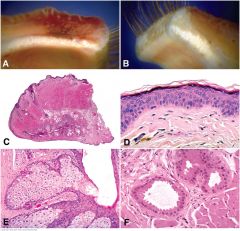
|
A. Upper eyelid. The upper eyelid is roughly rectangular compared to the lower lid, which is much shorter and triangular in shape. The anterior surface of the lid is covered by skin. A row of cilia (eyelashes) arises near the lid margin (at right) and curves away from the globe. The white foci seen below are the lobules of a Meibomian gland in the tarsal plate, the eyelid's fibrous skeleton. The palpebral conjunctiva is tightly adherent to the back surface of the tarsal plate. B. Lower eyelid. The lower eyelid is roughly triangular and has a much shorter tarsal plate and fewer meibomian glands. C. Histology, lower eyelid. The anterior surface of the eyelid is covered by a delicate layer of skin. The posterior surface is covered by the palpebral conjunctiva, which is firmly adherent to the tarsal plate. The tarsal plate contains large sebaceous glands called the Meibomian glands. Eosinophilic bundles of orbicularis muscle are seen in cross section in the connective tissue anterior to the tarsus. The tarsal plate of the lower lid is much shorter. The lower lid is roughly triangular in shape. D. Eyelid skin. The skin of the eyelid is extremely delicate and lacks rete pegs. The layers of the epidermis include the basal cell layer, the malpighian or prickle cell layer, the granular cell layer, and the superficial keratin layer. E. Meibomian gland lobule, eyelid. Each Meibomian gland is composed of multiple sebaceous gland lobules arranged along a central duct, which is oriented perpendicular to the lid margin. Sebaceous glands are holocrine glands; lipidized cells shed into the duct comprise the secretory product. Cellular division occurs in the basal cell layer in the periphery of the lobules. The nuclei become increasingly pyknotic as the cells mature and become lipidized. A flaplike valve of ductal epithelium covers the opening of this lobule. F. Glands of Moll. The dilated lumina of these apocrine sweat glands are lined by tall eosinophilic cells capped with the apical snouts that characterize apocrine decapitation secretion. (C. H&E ×10, D. H&E ×50, E. H&E ×50, F. H&E ×100)
|
|

|
A. Hyperkeratosis. The superficial layer of eosinophilic keratin is markedly thickened. The dead cells comprising the mass of keratin lack nuclei. A granular cell layer is present beneath the keratin. The epidermis in this specimen is mildly thickened. B. Parakeratosis, actinic keratosis. The keratin layer retains flattened nuclei, and no granular cell layer is present. Parakeratosis is typically found in actinic keratosis. In this example, the epidermis is composed of mildly atypical squamous cells. (A. H&E ×50, B. H&E ×100)
|
|

|
Chalazion. A. The focal area of nodular thickening in the upper eyelid represents a chronic granulomatous inflammatory response to irritating lipid material that has escaped from its normal compartment in the lid. Chalazia usually are only mildly tender and inflamed. Recurrent or atypical “chalazia” should be examined pathologically to exclude simulating lesions such as sebaceous carcinoma. B. Pink epithelioid histiocytes and giant cells indicative of chronic granulomatous inflammation surround an empty lipid vacuole. The lipid was dissolved by fat solvents during processing. Empty lipid vacuoles are required for the diagnosis of lipogranulomatous inflammation. The inflammatory infiltrate also contains many plasma cells and lymphocytes. (B. H&E ×100)
|
|

|
Viral lesions. A. Verruca vulgaris. Viral papilloma is composed of spire-shaped fronds of hyperkeratotic epidermis. B. Parakeratosis and vacuolated cells containing viral inclusions are seen on crest of frond. C. Herpes simplex infection of the skin. Serous fluid and inflammatory cells fill herpetic vesicle that has formed within the acantholytic epidermis. The underlying dermis is intensely inflamed. D. Multinucleated giant cells with Cowdry type A intranuclear inclusions are present. (A. H&E ×25, B. H&E ×250, C. H&E ×25, D. H&E ×250)
|
|
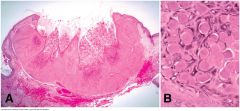
|
Molluscum contagiosum. A. This viral tumor has a typical crateriform configuration. Inclusions of pox virus shed by the infected acanthotic epithelium fill the crater. B. Henderson-Patterson corpuscles. The pox virus infection causes lobular acanthosis of the epidermis. The thickened epidermis contains large oval intracytoplasmic viral inclusions called Henderson-Patterson corpuscles. The inclusions become increasingly basophilic as they mature. (A. H&E ×10, B. H&E ×100)
|
|

|
Epidermal inclusion cyst. A. Epidermal inclusion cysts typically are round or oval and unilocular. The lumen of the cyst contains laminated eosinophilic keratin, which had a cheesy appearance grossly. The cyst is lined by keratinized squamous epithelium that resembles skin but lacks epidermal appendages. B. The surface of the skin is seen at top left. The cyst is lined by keratinized stratified squamous epithelium resembling epidermis. Laminated keratin fills lumen. (A. H&E ×5, B. H&E ×50)
|
|

|
Eccrine hidrocystoma. A. Cysts caused by the blockage of eccrine sweat glands often involve the canthal skin. Multiple cysts occur in some patients. They are filled with watery fluid. Eccrine hidrocystomas also are called sweat ductal or sudoriferous cysts. B. The eccrine hidrocystoma is lined by a dual layer of epithelial cells (arrow) resembling the epithelium of an eccrine sweat gland duct. The lumen is filled with eosinophilic granular debris consistent with serous fluid. The lumen is often branching and multilocular. (B. H&E ×100)
|
|

|
Squamous papillomas. A. Squamous papillomas are very common benign epidermal tumors of the eyelid. They are branching tree-shaped lesions composed of multiple fronds of benign epidermis. A large papilloma is present on upper eyelid. B. Smaller pedunculated papillomas are called skin tags, acrochordons, or fibroepithelial polyps. C. Multiple fronds or fingerlike projections of epidermis comprise the benign epidermal tumor. The epidermal fronds contain a central core of fibrovascular tissue. Hyperkeratosis is present on the surface of this lesion. (C. H&E ×25)
|
|

|
Keratoacanthoma. A. Keratin fills irregular crater in large biopsy-confirmed keratoacanthoma of the lower eyelid. The tumor developed rapidly. Some authorities now believe that keratoacanthoma is a “deficient squamous cell carcinoma” that tends to involute spontaneously. B. A mass of keratin fills the crater-shaped tumor, which is composed of squamous cells with eosinophilic cytoplasm. A lateral buttress of normal skin is seen at right. The base of the lesion has a smooth “pushing” margin. The general configuration of the lesion is important in histopathologic diagnosis. It usually is impossible to distinguish keratoacanthoma from squamous cell carcinoma in a small incisional biopsy. (B. H&E ×5)
|
|
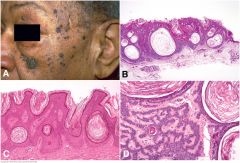
|
Seborrheic keratosis. A. Dermatosis papulosa nigra. Multiple seborrheic keratoses are seen on the face of this elderly African American woman. B. Benign sessile papilloma is situated anterior to the plane of the surrounding skin. Lesion contains many characteristic pseudohorn cysts. C. Thick layer of hyperkeratosis covers sessile papilloma. Characteristic pseudohorn cysts filled with keratin are present. D. Seborrheic keratosis, adenoid type. The dermis contains interweaving bands of benign epithelial cells. Several keratin-filled pseudohorn cysts are present. (B. H&E ×10, C. H&E ×25, D. H&E ×50)
|
|

|
A. Actinic keratosis. A surface plaque of parakeratosis covers a thickened segment of epidermis that is replaced by atypical squamous cells. Irregular buds of atypical keratinocytes extend into the papillary dermis at the base of some lesions. The dermis shows actinic elastosis. Normal epidermis is seen at right. B. Squamous cell carcinoma arising from actinic keratosis. Atypical squamous cells remain confined by the basement membrane of the markedly acanthotic epithelium at left. Eosinophilic squamous cell carcinoma invades the dermis at right. The tumor has incited a chronic inflammatory response. (A. H&E ×100, B. H&E ×10)
|
|

|
Squamous cell carcinoma. A. Eosinophilic nests of squamous cell carcinoma infiltrate the eyelid margin. A thick layer of surface keratinization is present. B. Infiltrating nests of squamous cell carcinoma are composed of neoplastic squamous cells with abundant eosinophilic cytoplasm. (A. H&E ×10, B. H&E ×100)
|
|
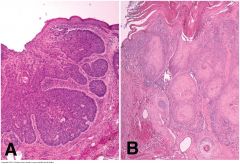
|
Basal and squamous cell carcinoma. A. Invasive basal cell carcinoma (at left) appears basophilic because tumor cells have scant cytoplasm. Peripheral palisading and retraction artifact are present. B. Invasive squamous cell carcinoma is composed of cells with eosinophilic cytoplasm. The surface is keratinized. (A. H&E ×25, B. H&E ×50)
|
|
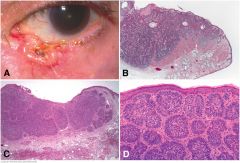
|
Basal cell carcinoma. A. Nodulo-ulcerative basal cell carcinoma of lower lid has pearly elevated margins. B. Basal cell carcinoma of lower eyelid appears “blue and below.” Its cells are basophilic and are located deep to the plane of the epidermis. C. The surface of this tumor is ulcerated. Basophilic lobules invade dermis. D. Well-differentiated basal cell carcinoma is composed of nests of basaloid cells that show peripheral palisading of nuclei. Retraction artifact is not present. No connection with epidermis is evident in this field. (D. H&E ×100)
|
|

|
Morpheaform basal cell carcinoma. A. Neglected morpheaform basal cell carcinoma has produced ghastly facial disfigurement. B. Morpheaform basal cell carcinoma is a poorly differentiated variant of basal cell carcinoma that is composed of slender infiltrating tendrils of tumor cells similar to those found in scirrhous breast carcinoma. The margins of morpheaform basal cell carcinoma are often indistinct clinically, and the tumor tends to infiltrate deeply. (B. H&E ×25)
|
|
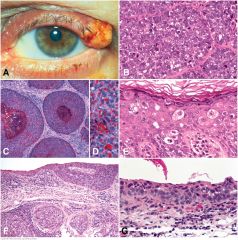
|
Sebaceous carcinoma. A. Tumor of upper eyelid has yellow color that indicates presence of lipid. Madarosis is present. B. Tumor is composed of lobules of cells with foamy vacuolated cytoplasm. Numerous mitoses are present. Peripheral palisading is not seen. C. Large lobules of sebaceous carcinoma show central necrosis (comedocarcinoma pattern) mimicking holocrine secretion. D. Oil red O stain performed on frozen sectioned material confirms the presence of lipid in cytoplasmic vacuoles. E. Pagetoid invasion of eyelid skin by sebaceous carcinoma. Individual tumor cells with vacuolated cytoplasm from an underlying sebaceous carcinoma infiltrate the epidermis in a fashion analogous to Paget disease of the breast. F. Tarsal conjunctiva shows intraepithelial sebaceous carcinoma. Lobules of tumor are present in tarsal plate. G. Intraepithelial sebaceous carcinoma, conjunctiva. Atypical cells with large, hyperchromatic nuclei and cytoplasmic vacuoles replace basal half of conjunctival epithelium. (B. H&E ×100, C. Oil red O ×50, D. Oil red O ×250, E. H&E ×100, F. H&E ×50, G. H&E ×100)
|
|

|
A. Senile sebaceous gland hyperplasia. Lobules of mature benign hyperplastic sebaceous glands form a nodule in the dermis. These show typical arrangement around central duct. The nodule was misdiagnosed as basal cell carcinoma preoperatively. B. Sebaceous adenoma. Incompletely lipidized cells comprising low-grade sebaceous neoplasm form disorderly lobules. Differential diagnosis included sebaceous adenoma or low-grade sebaceous carcinoma. Sebaceous adenomas serve as a clinical marker for systemic malignancy in patients with the Muir-Torre syndrome. (A. H&E ×10, B. H&E ×100)
|

